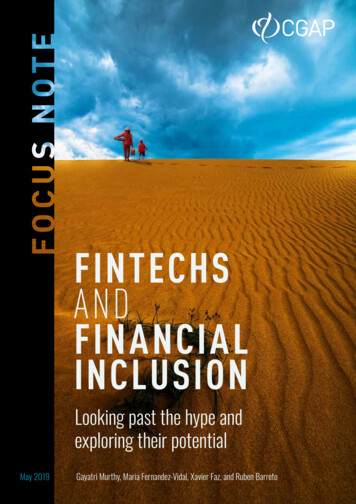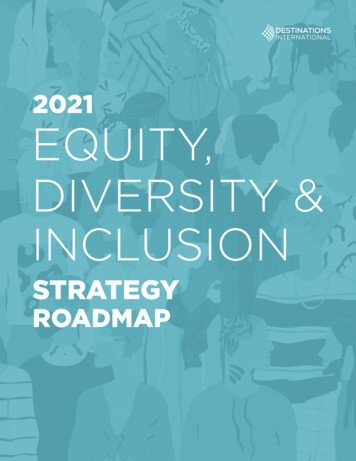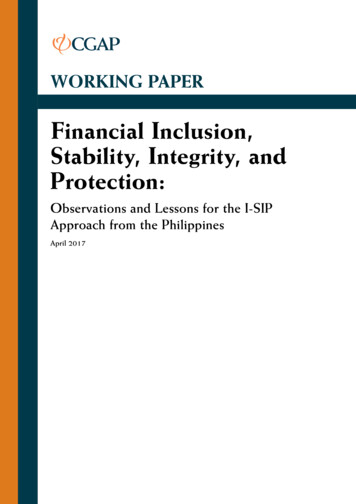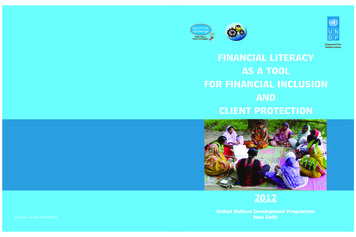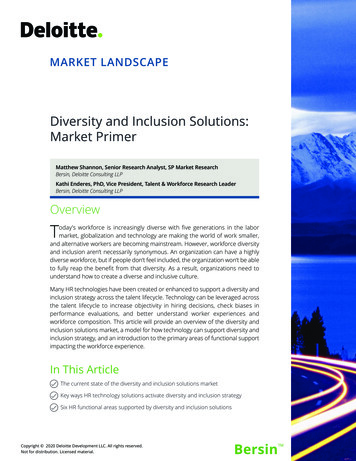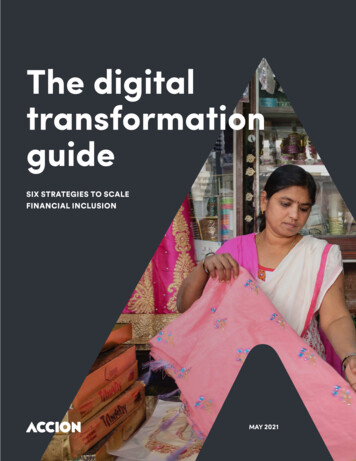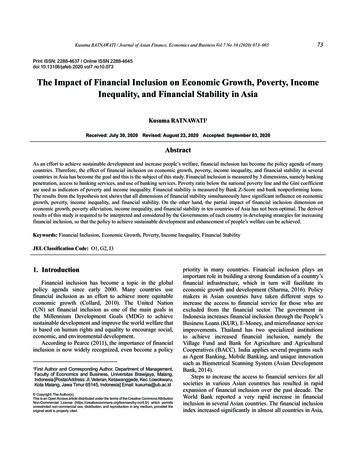
Transcription
Kusuma RATNAWATI / Journal of Asian Finance, Economics and Business Vol 7 No 10 (2020) 073–08573Print ISSN: 2288-4637 / Online ISSN 2288-4645doi:10.13106/jafeb.2020.vol7.no10.073The Impact of Financial Inclusion on Economic Growth, Poverty, IncomeInequality, and Financial Stability in AsiaKusuma RATNAWATI1Received: July 30, 2020Revised: August 23, 2020 Accepted: September 03, 2020AbstractAs an effort to achieve sustainable development and increase people’s welfare, financial inclusion has become the policy agenda of manycountries. Therefore, the effect of financial inclusion on economic growth, poverty, income inequality, and financial stability in severalcountries in Asia has become the goal and this is the subject of this study. Financial inclusion is measured by 3 dimensions, namely bankingpenetration, access to banking services, and use of banking services. Poverty ratio below the national poverty line and the Gini coefficientare used as indicators of poverty and income inequality. Financial stability is measured by Bank Z-Score and bank nonperforming loans.The results from the hypothesis test shows that all dimensions of financial stability simultaneously have significant influence on economicgrowth, poverty, income inequality, and financial stability. On the other hand, the partial impact of financial inclusion dimension oneconomic growth, poverty alleviation, income inequality, and financial stability in ten countries of Asia has not been optimal. The derivedresults of this study is required to be interpreted and considered by the Governments of each country in developing strategies for increasingfinancial inclusion, so that the policy to achieve sustainable development and enhancement of people’s welfare can be achieved.Keywords: Financial Inclusion, Economic Growth, Poverty, Income Inequality, Financial StabilityJEL Classification Code: O1, G2, I31. IntroductionFinancial inclusion has become a topic in the globalpolicy agenda since early 2000. Many countries usefinancial inclusion as an effort to achieve more equitableeconomic growth (Collard, 2010). The United Nation(UN) set financial inclusion as one of the main goals inthe Millennium Development Goals (MDG) to achievesustainable development and improve the world welfare thatis based on human rights and equality to encourage social,economic, and environmental development.According to Pearce (2011), the importance of financialinclusion is now widely recognized, even become a policyFirst Author and Corresponding Author. Department of Management,Faculty of Economics and Business, Universitas Brawijaya, Malang,Indonesia [Postal Address: Jl. Veteran, Ketawanggede, Kec. Lowokwaru,Kota Malang, Jawa Timur 65145, Indonesia] Email: kusuma@ub.ac.id1 Copyright: The Author(s)This is an Open Access article distributed under the terms of the Creative Commons AttributionNon-Commercial License (https://creativecommons.org/licenses/by-nc/4.0/) which permitsunrestricted non-commercial use, distribution, and reproduction in any medium, provided theoriginal work is properly cited.priority in many countries. Financial inclusion plays animportant role in building a strong foundation of a country’sfinancial infrastructure, which in turn will facilitate itseconomic growth and development (Sharma, 2016). Policymakers in Asian countries have taken different steps toincrease the access to financial service for those who areexcluded from the financial sector. The government inIndonesia increases financial inclusion through the People’sBusiness Loans (KUR), E-Money, and microfinance serviceimprovements. Thailand has two specialized institutionsto achieve increased financial inclusion, namely theVillage Fund and Bank for Agriculture and AgriculturalCooperatives (BACC). India applies several programs suchas Agent Banking, Mobile Banking, and unique innovationsuch as Biometrical Scanning System (Asian DevelopmentBank, 2014).Steps to increase the access to financial services for allsocieties in various Asian countries has resulted in rapidexpansion of financial inclusion over the past decade. TheWorld Bank reported a very rapid increase in financialinclusion in several Asian countries. The financial inclusionindex increased significantly in almost all countries in Asia,
74Kusuma RATNAWATI / Journal of Asian Finance, Economics and Business Vol 7 No 10 (2020) 073–085such as in Malaysia which reached 80.7 in 2014, which isa increase of 14.5 percent from 2011; while in India andIndonesia it increased by 2 times in 2014 compared to 2011(World Bank, 2015) (see Figure 1).The main objective of financial inclusion programscarried out by countries in Asia is to encourage inclusivegrowth through reducing poverty, increasing development,income distribution, and financial system stability (BankIndonesia, 2014). However, the rapid increase of financialinclusion in Asia in 2014 was not accompanied by an increasein economic growth; even some countries experienced aneconomic slowdown. The data of economic growth in Asiareported by the Asian Development Bank in Figure 1 showsthe Gross Domestic Product (GDP) growth rate of severalcountries experienced a sharp decline in 2014.In Figure 1, it can be seen that Thailand, Singapore,Indonesia, the Philippines, and several other countriesexperienced a decline in GDP growth rates as well as incomeinequality in 2014. Based on the data from the World Bank(2016) as presented in Figure 2(a), income inequality in thelast few decades has increased in several Asian countries. Thisshows that the main objective of financial inclusion whichtheoretically can increase the economic growth and reduceincome inequality is not in accordance with the phenomenonin Asia. On the other hand, poverty rates in several Asiancountries have decreased significantly, as Figure 2(b) showsa drastic reduction in the ratio of poor population in Asia.Thus, the increase of financial inclusion in Asia in the last fewdecades is accompanied by a reduction in poverty levels, whichis consistent with the aims of financial inclusion (see Figure 2).Figure 1: GDP Growth Rates in Several Countries in AsiaSource: Asian Development Banka. Income Inequalityb. Ratio of Poor PopulationFigure 2: Income Inequality and Poverty of Several Asian CountriesSource: World Bank, 2016
Kusuma RATNAWATI / Journal of Asian Finance, Economics and Business Vol 7 No 10 (2020) 073–085This phenomenon shows that there is a gap betweenthe theoretical purposes of financial inclusion with thereal circumstances in Asia. Several studies have provenstrong positive relationship between financial inclusion andeconomic growth (Kendall et al., 2010; Ghosh, 2011; Sarma& Pais, 2011; Mihasonirina & Kangni, 2011; Masoud &Hardaker, 2012; Demirguc-Kunt & Klapper, 2012; Sharma,2016; Pradhan et al., 2016; Kim, Yu, & Hassan, 2018; Gul etal., (2018); Raza et al., 2019), while Naceur and Ghazouani(2007) and Khan (2011) shows that financial inclusion has anegative influence on economic growth.Other studies also examine the relationship betweenfinancial inclusion, poverty, and income inequality invarious countries with diverse methods and findings. Becket al. (2007), Brune et al. (2011), Dixit and Ghosh (2013), Leand Nguyen (2020), and Sanjaya (2014) stated that financialinclusion can reduce poverty and income inequality.Park and Mercado (2015), Schmied and Marr (2016), andBoukhatem (2016) also found empirical evidence of anegative relationship between financial inclusion, poverty,and income inequality. On the contrary, Dhrifi (2013), Sevenand Coskun (2016), and Neaime and Gaysse (2018) foundthat financial inclusion does not have a significant influenceon poverty and income inequality.Likewise, there are different findings on the relationshipbetween financial inclusion and financial stability. Hanningand Jansen (2010), Prasad (2010), Morgan and Pontines(2014), Dienillah and Anggraeni (2016), Ozili (2018),Neaime and Gaysse (2018), and Ahamed and Mallick(2019) found that financial inclusion positively influencesfinancial stability. Sanusi (2011) argues that there is noeconomy that can achieve financial stability, economicsustainability, and inclusive growth without achieving a highlevel of financial inclusion. Different results on the impactof financial inclusion and financial system stability wereobtained by Khan (2011) and Mehrotra and Yetman (2015)who stated that financial inclusion negatively influencedfinancial stability. In addition, Dupas et al. (2012) added thatthe increase in banking services did not cause an increase infinancial stability because it was not followed by a decreasein borrowing costs for the lower middle class as well as anincrease in service quality, and lack of trust.The phenomenon of the increase of a quite rapidfinancial inclusion in Asia that is not accompanied byincreased economic growth and reduction of incomeinequality, as well as inconsistent research findings and thelack of comprehensive research that examines the impact offinancial inclusion on economic growth, poverty, incomeinequality, and financial stability becomes the main basis forthe author to examine the influence of financial inclusiontoward economic growth, poverty, income inequality, andfinancial stability in Asia. The results of this study will helppolicy makers to design and implement programs that will75expand access to financial services, which lead to increasedeconomic growth, poverty reduction, income distribution,and financial stability, which in turn will be able to helpachieve sustainable development.2. Literature Review2.1. Financial Inclusion and Economic GrowthEconomic growth is an achievement through a processsupported by various sectors in the economy, one of whichis the financial sector. There are four roles of the financialsector that are beneficial for the economy, namely: (1)being able to reduce risk; (2) mobilize savings; (3) reducetransaction and information costs; and (4) encouragespecialization (Levine, 2005). Furthermore, Fabya (2011)added that the financial sector is able to provide borrowersvarious financial instruments with high quality and low risk,which ultimately will accelerate economic growth.Several studies have examined the relationship betweenfinancial inclusion and economic growth. Kendall et al.(2010) and Ghosh (2011) evaluate the role of financialaccess in economic growth with the data from Indian subnational level which proves the positive impact of access tofinancial services and use of financial services on economicgrowth in India. Mihasonirina and Kangni (2011) also foundthe significance of financial inclusion and communicationtechnology toward economic growth. Martinez et al. (2011)argued that access to finance is an important policy tool usedby governments and policy makers to stimulate economicgrowth. By making finance available and affordable forall economic agents, it will affect the growth of economicactivities that will increase the output. Sarma and Pais(2011) found empirical evidence of a relationship betweenfinancial inclusion and economic growth using data from 49countries. Falahaty and Hook (2013) showed that financialdevelopment is a significant determinant of economicgrowth. This finding shows that improving the function ofthe banking sector is very crucial to spur economic growth.Law, Azman-Saini, and Hui (2014) emphasized that a welldeveloped financial system is essential for economic growth.Furthermore, Sarma (2016) continued the study by analyzingthe causality relationship between various dimensions offinancial inclusion and economic growth, which proves thatthere is a two-way causality relationship between access tobanking services and economic growth. Recently, Pradhan etal. (2016), Kim et al. (2018), and Raza et al. (2019) provedthat there is a significant positive relationship betweenfinancial inclusion and economic growth.On the contrary, Naceur and Ghazounai (2007)examined the relationship between financial developmentand economic growth for 11 countries in the Middle Eastand North Africa and found that bank development has a
76Kusuma RATNAWATI / Journal of Asian Finance, Economics and Business Vol 7 No 10 (2020) 073–085negative influence on economic growth. Khan (2011) alsoshowed that financial inclusion has a negative influenceon economic growth. Financial inclusion can lower loanstandards because financial institutions are trying to reachthe lower community by lowering loan terms, but it can alsoincrease the risk of a bank’s reputation, as several countrieslower the standard of establishing financial institutions forrural areas.2.2 Financial Inclusion, Poverty, and IncomeInequalityFinancial inclusion can lift the financial condition andstandard of living of poor and reduce income inequality(Beck et al, 2007). According to Brune et al. (2011), savingallows families to increase their capacity to absorb financialshocks, smooth consumption, accumulate assets, and investin health and education. Access to financial services hasthe potential to remove the poor from the cycle of povertythrough a culture of saving and creating efficient and lowcost payment mechanisms (Dixit & Ghosh, 2013). Sanjaya(2014) obtained results that financial inclusion throughmicro credit programs can improve social and economicstatus of the poor. Park and Mercado (2015) found empiricalevidence of a negative relationship between financialinclusion, poverty, and income inequality. Boukhatem (2016)investigated the contribution of financial development levelon poverty reduction in 67 low and middle income countriesduring 1988-2012 and found that the increase of financialdevelopment directly influences poverty reduction.Dhrifi (2013) obtained different findings that financialdevelopment encourages economic growth and reducespoverty in middle and high income countries, while in lowincome countries, the financial system does not have positiveinfluence on economic growth. On the other hand, Nguyenet al. (2020) conducted research in Vietnam and foundthat economic growth positively contributes to povertyreduction. Seven and Coskun (2016) stated that althoughfinancial development encourages economic growth, it doesnot necessarily benefit low-income people in developingcountries, as they found that financial inclusion does notplay an important role in poverty reduction. The latestresearch conducted by Neaime and Gaysse (2018) foundthat financial inclusion does not have significant influencetoward poverty.2.2. Financial Inclusion and Financial StabilityFinancial inclusion can have both positive and negativeinfluences on financial stability. The positive influenceincludes diversification of bank assets, increasing stabilityof deposit base, and increased monetary policy transmission,while the negative influence includes a decrease in loanstandards, bank reputation risk, and inadequate regulations.Hannig and Jansen (2010) argued that financial inclusionalso has the potential to improve financial stability, becausepoor people’s access to formal financial institutions’ savings canincrease household capacity to manage financial vulnerabilitiescaused by the adverse effects of the crisis, diversify thefunding base from financial institution that can reduce shockswhen global crisis occur, increases economic resilience byaccelerating growth, facilitate diversification, and reducepoverty. Prasad (2010) added that at the state level, financialinclusion can increase efficiency in financial intermediationthrough domestic savings and increase in investment toencourage financial stability. Aduda and Kulanda (2012)examined financial inclusion and financial stability in Kenya,and found that financial inclusion is a perquisite for economicgrowth and development because various financial programshave an impact on Kenya’s financial stability. Morgan andPontines (2014) stated that an increase in availing by SMEswill increase financial stability. According to Dienillah andAnggraeni (2016), the increase of financial inclusion, bankingassets, GDP per capita, and portfolio investment can be a goodstrategy to improve financial stability. Neaime and Gaysse(2018), Ahmed and Mallick (2019), and Pham and Doan(2020) stated that the increase of financial inclusion positivelycontributes to financial stability.Khan (2011) and Dupas et al. (2012) obtained differentresults regarding the relationship between financialinclusion and financial stability. Financial inclusion has anegative influence on financial stability, as it can reduceloan standards because financial institutions try to reachthe lower-income groups by lowering loan terms (Khan,2011). Dupas et al. (2012) found that an increase inbanking services in Kenya does not lead to an increase infinancial stability because it is not followed by a decreasein borrowing costs for the lower-middle-class, increasein service quality, and because there is a lack of trust.Financial inclusion achieved through rapid loan growthor fund intermediation that is not accompanied by properregulation can negatively influence financial stability(Mehrotra & Yetman, 2015). Based on the literature review,the hypothesis proposed in this study is:H1. Financial Inclusion (banking penetration, access tobanking services, and use of banking services) significantlyinfluences Economic Growth in Asia.H2. Financial Inclusion (banking penetration, access tobanking services, and use of banking services) significantlyinfluences Poverty in Asia.H3. Financial Inclusion (banking penetration, access tobanking services, and use of banking services) significantlyinfluences Income Inequality in Asia.
Kusuma RATNAWATI / Journal of Asian Finance, Economics and Business Vol 7 No 10 (2020) 073–085H4a. Financial Inclusion (banking penetration, access tobanking services, and use of banking services) significantlyinfluences Financial Stability (bank non-performing loans tototal gross loans) in Asia.H4b. Financial Inclusion (banking penetration, access tobanking services, and use of banking services) significantlyinfluences Financial Stability (Bank Z-Score) in Asia.3. Research MethodThe object of this study is 10 developing countries inAsia: Afghanistan, Bangladesh, Brunei Darussalam, India,Indonesia, Malaysia, Pakistan, Philippines, Singapore, andThailand, which are selected on the basis of the FinancialInclusion Index published by the International MonetaryFund (IMF). The research period is based on the year after thecrisis to the availability of the latest data, namely 2009-2018.The independent variable of this study is FinancialInclusion (X), which consists of banking penetration (X1),indicated by population who has bank account; access tobanking services (X2), indicated by number of bank officeand ATMs spread across an area; and use of banking services(X3), indicated by amount of deposits and loans extended. Thedependent variable used is economic growth (Y1), indicatedby GDP per capita growth; poverty (Y2), indicated by theratio of poverty numbers below the national poverty line(% of total population); income inequality (Y3), indicatedby Gini coefficient; and financial stability (Z), indicated bybank Z-score and bank nonperforming loans to total grossloans. The data used in this study is annual secondary datacollected from the World Bank, International Monetary Fund(IMF) database, and others.Hypothesis testing is done using a dynamic data panelmodel of Generalized Method of Moments (GMM), followingRioja and Valev (2004), Beck et al. (2007a, b) and Neaime andGaysse, (2018). To measure the strength of the relationshipbetween financial inclusion and income inequality/poverty,researchers used the inflation rate control variable followingRavallion and Datt (1999), Easterly and Fischer (2001),Dollar and Kray (2002), and Neaime and Gaysse (2018). Theequation for the dynamic panel data model to measure theinfluence of financial inclusion toward economic growth,poverty, and income inequality is as follows:PNLZ it α i ϕ j Z it 1 γ j X jit β k Ykit ε it ,k 1 j 1 j 1 Note:i Cross-country units (country)t Period of time t (years)X Proxy for financial inclusion variable77Y Independent economic variable vector (inflation)Z Proxy for variable of economic growth, poverty,and income inequalityαi Unobserved fixed effectεit The error rate that distributed independentlyFurthermore, to see how banking penetration, access tobanking services, and use of banking services can improvefinancial stability, this equation is proposed:STAB α iNL b X cijijk 1 j 1 Note:iSTABXMa, bj, and ckεiikM ik ε i Cross-country units (country) Proxy for financial stability Proxy for financial inclusion variable Vector of the factors related to country i Parameter Error rateThe vector of M variable includes: (1) Log populationsize; (2) GDP per capita growth; (3) Gini Coefficient forincome inequality; and (4) The average inflation during theobservation period. To avoid multicollinearity problems, themodel is estimated using GMM estimation procedure forlinear model in panel data context. Model estimation methodenables AR (1) autocorrelation type in the panel and crosssectional and heteroscedasticity correlation across panels.4. Results and Discussion4.1. Descriptive Statistic AnalysisThe descriptive statistic of research variables is presentedin Table 1. This shows that there is a large financial inclusiongap between 10 developing countries in Asia as shown bythe significant difference between minimum and maximumvalue of the indicators. The data variation for the ‘number ofcommercial bank branch offices’ is low, as indicated by thestandard deviation value of 4.979. Likewise, data variations forthe number of ATMs, Outstanding Deposits with CommercialBanks, and Outstanding Loans from Commercial Banks arenot too high. Thus, the dimension of access to and use ofbanking services in Asian countries are not much different.The dependent variable of economic growth indicated byGDP per capita growth shows quite high data variation. Thereis a fairly high difference in poverty in 10 Asian countries,while the variation level of income inequality and financialstability in these countries is still low. This indicates thatthe income inequality and financial stability between thesecountries are not much different (see Table 1).
78Kusuma RATNAWATI / Journal of Asian Finance, Economics and Business Vol 7 No 10 (2020) 073–085Table 1: Descriptive Statistics of Financial Inclusion and Economic Growth Indicator of 10 Asian Countries during 2009-2018Min.Max.AverageStd. DevSkewnessKurtosisNumber of Account at Commercial Bank88.1262486.3771187.037781.4040.180-1.513Number of Commercial Bank Branch Office2.01923.68210.8474.9790.6340.652Number of Commercial Bank ATMs0.452117.27938.09933.6630.646-0.661Outstanding Deposits with Commercial g Loans from Commercial Banks2.958152.20050.46639.5071.0680.098Economic 54.50021.73712.3700.3540.460Income Inequality29.00047.80037.5715.1290.343-0.870Bank Z-Score10.29026.28412.5875.7680.420-0.941Bank nonperforming loans to total gross loans0.40016.2074.9323.8081.0900.196Table 2: Results of the Influence of Financial Inclusion on Economic Growth in AsiaVariableCoefficientStd. Errort-StatisticProb.Economic al Bank Branch-0.0035930.951857-0.0037750.9970Number of Account-0.0027410.003496-0.7842560.4354Number of ATM0.1040140.0725911.4328770.1562Outstanding Deposit-0.1437030.228564-0.6287220.5315Outstanding 769850.5034Prob(F-statistic)0.0000***Adjusted R-squared0.336791Note: *** Significant in 1% significance level** Significant in 5% significance level4.2 Hypothesis Testing4.2.1. The Influence of Financial Inclusion towardEconomic Growth in AsiaThe hypothesis testing of the influence of financialinclusion toward economic growth in Asia is done usingdynamic data panel model of Generalized Method ofMoments (GMM) using EViews 7 application. The resultsare shown in Table 2:Based on Table 2, it can be derived that simultaneously (Ftest), financial inclusion significantly influences economicgrowth in Asia with 1% significance level. However, theR2 of financial inclusion is very small, only 37.7%. Thus,financial inclusion only explains the economic growth of37.7%, while 62.3% is explained by other variables.It indicates that the increase of financial institutions inAsia can increase economic growth as shown in the graphicof economic growth development. The rapid increase in3 dimensions of financial inclusions (banking penetration,access to banking services, and use of banking services) canincrease economic growth in India, Bangladesh, Pakistan,Singapore, and Indonesia in 2013-2018. The increase offinancial inclusion is aimed to create capital accumulationwhich in turn increases economic growth.The financial inclusion through credit amount canincrease investment in activities with high added value,thereby increasing economic growth through the country’soutput (Febya, 2011). By making finance available andaffordable to all economic agents, the growth of economicactivity will increase a country’s output. Law, Azman-Saini,and Tan (2014) emphasized that a well-developed financialsector is essential for economic growth.This finding is in accordance with Martinez et al. (2011)who stated that access to finance is an important policytool used by governments and policy makers to stimulateeconomic growth. Sarma and Pais (2011); Sarma (2016);Sanjaya (2016); Kim et al. (2018), and Raza et al. (2019)
Kusuma RATNAWATI / Journal of Asian Finance, Economics and Business Vol 7 No 10 (2020) 073–085also proved that financial inclusion significantly influenceseconomic growth.Based on the GMM test results summarized in Table 2,there is only one financial inclusion indicator that showssignificantly positive influence toward economic growth,namely loan amount with 5% significance level. This showsthat the loans amount disbursed by banks can significantlyincrease economic growth.It is consistent with the focus of the National FinancialInclusion Strategy of 10 Asian countries which has becomean object of research. Most of them focus on increasing theloan amount, especially for productive economic sectorsincluding rural sectors such as agriculture and MSMEs incountries like Afghanistan, and Indonesia. Governmentand central bank of Bangladesh have intensified effortsto increase financial inclusion with refinancing loans tofarmers, micro and small enterprises, renewable energy, andwaste treatment projects.Bank loans have an important role in financing a country’seconomy. The availability of loans enables householdscompanies to consume better and make investments thatcannot be done with their own funds. Thus, an increase inloans extended by banks will increase productivity so thatthe level of economic growth can also be higher (Goldsmith,1969; Beck et al. 2000; Christopouluos & Tsionas, 2004).The increase of loan provision for productive sectors,especially agriculture and MSMEs, allows for significantincrease in productivity thus economic growth can beachieved optimally.Other indicators of financial inclusion dimensions,namely the number of accounts at commercial banks, thenumber of commercial bank branches, number of ATMs, andnumber of deposits have no significant effect on economicgrowth. This is possibly because these indicators do notdirectly influence economic growth.4.2.2. The Influence of Financial Inclusion towardPoverty in AsiaThe hypothesis test results of the influence of financialinclusion toward poverty in Asia are shown in Table 3.Simultaneously (F test), financial inclusion significantlyinfluences poverty in Asia with 1% significance level. TheR2 of financial inclusion toward poverty is 69.5%. Therefore,financial inclusion can explain poverty of 69.5%, while31.5% is explained by other variables.These findings prove that the increase of financial inclusionin Asia can reduce poverty levels. This is consistent with thepoverty rate development which shows a decline from 2013to 2018 in Pakistan, Bangladesh, India, Indonesia, Malaysia,Philippines, and Thailand. Inclusive financial system plays animportant role in poverty alleviation. People with access tofinancial services tend to be more productive by consuming79and investing more to improve their standard of living (Ashrafet al., 2006). Financial inclusion will greatly help marginalizedand low-income groups to increase their income, accumulatewealth, manage risks, and make efforts to get out of poverty.One of the main objectives of the National FinancialInclusion Strategy is to increase community welfare and povertyalleviation through increasing access of the lower middle classto the formal financial system. Access for the poor to formalfinancial institutions can increase household capacity to managefinancial vulnerabilities caused by the adverse effects of thecrisis, diversify the funding base from financial institutions,increase economic resilience by accelerating growth, facilitatediversification, and reduce poverty (Hanning & Jansen, 2010).Lack of access to finance can adversely affect economicgrowth and poverty alleviation, as the poor find it difficult toaccumulate savings, build assets to protect themselves fromrisks, and invest in income-generating projects.These results are consistent with Dixit and Ghosh (2013)who stated that access to financial services has the potential toreduce poverty rate. Financial inclusion through micro creditprograms can increase social and economic status of the poor(Sanjaya, 2014). Beck, et al. (2007), Brune et al. (2011); Parkand Mercado (2015); Boukhatem (2016) also found empiricalevidence of significant negative influence between financialinclusion and economic growth. (See Table 3)Based on GMM test results in Table 3, it can
74 usuma RATNAWATI / Journal of Asian Finance, Economics and Business ol 7 No 10 (2020) 073–085 such as in Malaysia which reached 80.7 in 2014, which is a increase of 14.5 percent from 2011; while in India and I

